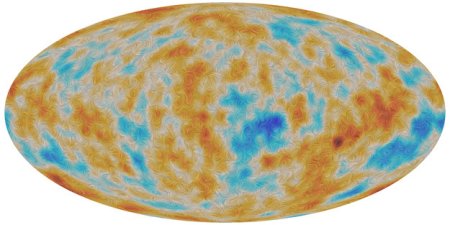
Credit ESA – Planck. Link at bottom.
The people behind the Planck telescope at ESA just released more data and an important news that could serve as a great example to explain that science is not dull and linear. Years ago, a brilliant astro-physicist gone too soon named Heinz R. Pagels, in a book titled The Cosmic Code, in fact linked mountaineering and mountain hiking, the most prevalent hobby of his trade as a reflection on what science is really about. Today’s new knowledge confirms it.
When the Big Bang occurred, after an incredibly short period called Planck time, it was incredibly hot and dense since it already contained all of the Universe’s energy and mass in a tiny space. 380 000 years later, light and matter separated and all we have left is a sort of echo, seeming to come from all regions of space dating from then, the Cosmic Microwave Background. So the lighter atoms formed ( mostly neutral Hydrogen and some Deuterium ) from a soup of electrons and protons and light began to wander except that there wasn’t that much of it.
Out of this relatively dark universe spawned incredible stars, hot and giant furnaces that molded heavier elements and re-ionized ( added charge ) to the neutral hydrogen present all around them. A marvelous instrument called WMAP by NASA gave us our first clue of when those stars had fired up. Its measurement however came to 420 000 for re_ionization which was a tad too short, being a mere 40 000 years after the Dark Ages had begun. ESA / Planck’s new data suggests 560 000 years after the Big Bang instead which solves the discrepancy. Hubble ( the space telescope too not the man ) had seen too few stars to fit WMAP’s estimate but the right number for the new bid.
All is well in the end, right? Well, not quite! Planck was looking at polarization this last period, the polarization of the CMB of course! It expected to find in it evidence of the super-rapid expansion that must have followed the initial Bang to account for the size and conditions of the cosmos as we see it now. It did not. Still, what it did record is consistent with the super-inflation theory and gives a more precise values range to look for it hence.
And here’s the catch : the new constraints eliminate all simple models of super-inflation, forcing scientists into new headaches over more complex models. This is where Pagels’ allegory finds its truth. He thought the hiker’s path in the mountains to copy science’s own path. Getting out of the pits to reach the summit only reveals the next valley and beyond it the next summit. Which is exactly what happened this time!
Lace those boots, Everests hide behind each discovery, Tay.
Source :
http://www.esa.int/Our_Activities/Space_Science/Planck/Planck_reveals_first_stars_were_born_late
